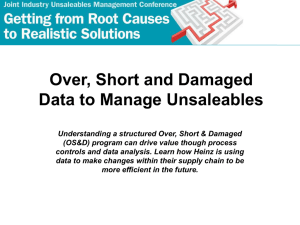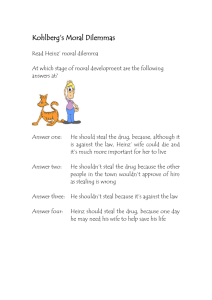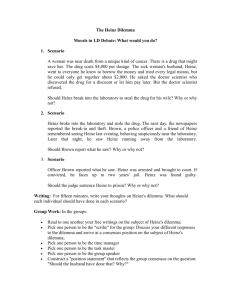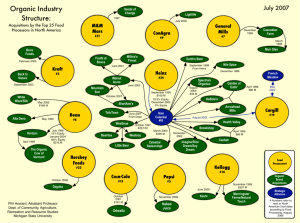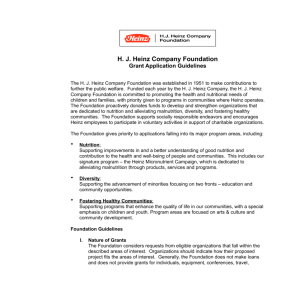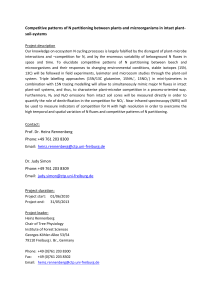Heinz Project
advertisement
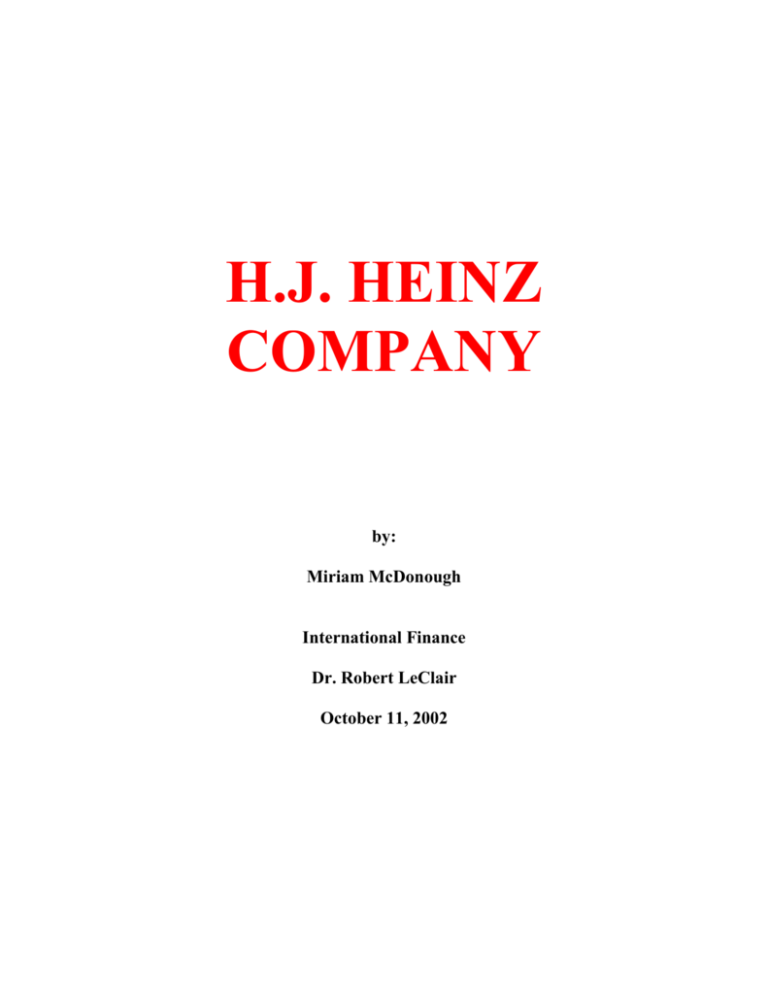
H.J. HEINZ COMPANY by: Miriam McDonough International Finance Dr. Robert LeClair October 11, 2002 Table of Contents Background of H. J. Heinz . . . . . . . . . . . . . . . . . . . . . . . . . . . . . . . . . . . . . . . . . . . . . . . . . 1 Ratio Analysis . . . . . . . . . . . . . . . . . . . . . . . . . . . . . . . . . . . . . . . . . . . . . . . . . . . . . . . .2 – 4 Common Size Financial Statement Analysis . . . . . . . . . . . . . . . . . . . . . . . . . . . . . . . . . . . 4 Sources and Uses of Funds . . . . . . . . . . . . . . . . . . . . . . . . . . . . . . . . . . . . . . . . . . . . . .4 – 5 Intrinsic Value Analysis . . . . . . . . . . . . . . . . . . . . . . . . . . . . . . . . . . . . . . . . . . . . . . . . 5 – 6 Appendix A . . . . . . . . . . . . . . . . . . . . . . . . . . . . . . . . . . . . . . . . . . . . . . Ratio Comparisons Appendix B . . . . . . . . . . . . . . . . . . . . . . . . . . . . . . . . . . . . . . . . . . . . .Financial Statements Appendix C . . . . . . . . . . . . . . . . . . . . . . . . . . . . . . . . . Common Size Financial Statements Appendix D . . . . . . . . . . . . . . . . . . . . . . . . . . . . . . . . . . . . . . . . Sources and Uses of Funds Appendix E . . . . . . . . . . . . . . . . . . . . . . . . . . . . . . . . . . . . . . . . . . . . . . . . . . . . .Projections Appendix F . . . . . . . . . . . . . . . . . . . . . . . . . . . . . . . . . . . . . . . . . . . . . . . . . . . . .Value Line Appendix G. . . . . . . . . . . . . . . . . . . . . . . . . . . . . . . . . . . . . . . . . . . . . . . . . . . Bibliography Background of H. J. Heinz H.J. Heinz Company manufactures and markets a large line of processed food products throughout the world. Established in 1869, Heinz went from selling on the local market, to selling on the national market, to selling on the global market. Heinz is known throughout the world for its consistent quality, old-fashioned values and great taste. When Henry Heinz was only twenty-five years old, he founded H.J. Heinz Company. Run by family members for decades to follow, Heinz expanded beyond its local start up point and ventured into the global market. Heinz’s first overseas endeavor began in 1905 when it began selling its products in London. From then on, worldwide expansion boomed. Heinz acquired companies in various countries such as Italy, Mexico, South Africa, Russia, China, India, and Zimbabwe, not to mention the companies that it has acquired in the United States. Heinz in represented in 200 countries across the globe and as fast as their locations have numbered, so have their product lines. Heinz’s leading products and major sources of cash flow include are the regular, garden-variety ketchup, condiments, and sauces. Other product lines include convenience meals, frozen foods, pet foods, infant foods, and organic and nutritional foods. Because each country has a different style, culture and taste, the different product lines are sold throughout the world on different levels. Today, H.J. Heinz Company stock is traded on the New York Stock Exchange under the ticker symbol HNZ. Currently Heinz has 351,100,000 shares outstanding. Ratio Analysis Performing a ratio analysis, I am able to look at the value of H.J. Heinz Company and compare it to that of the industry and one of its main competitor’s General Mills. By calculating and analyzing ratios from five different areas such as profitability, liquidity, debt management, efficiency and market vale, I am able see how Heinz measures up against its peers. First, I looked at the profitability ratios return on assets and return on equity. ROA indicates what earnings were generated from invested capital. Heinz’s ROA has grown between 2001 and 2002 and is above both the industry average and General Mill’s ROA. The Return on Equity demonstrates how profitable a company is in comparison with the industry. Again, Heinz’s ROE has grown from 2001 to 2002 and is extremely larger than the ROE of both the industry and General Mills. The profitability ratios indicate that Heinz is earning high above the average earning and is gaining enough profit to remain one of the top competitors in the industry. Analyzing the liquidity ratios, I looked at the current ratio and the quick ratio. The current ratio measures the ability of Heinz to meet its daily operating expenses and short-term obligations. Heinz’s current ratio shows that it meets its obligation faster and more efficiently than its competitors. The quick ratio measures how fast a company’s assets can be turned into cash. This measurement is also an indication of financial strength. Looking at this, it can be seen that Heinz is not quite as liquid as the average in its industry, but it is definitely more liquid and seemingly more powerful than General Mills. These ratios indicate that Heinz able to meet its obligations and is able to liquidate it assets in a short amount of time if necessary. Analyzing debt management ratios, I looked at the debt/equity ratio and the performance of Heinz compared to General Mills and the industry. The debt/equity ratio measures a company’s financial leverage, i.e. how much debt and how much equity a company uses to finance its assets. A higher ratio indicates an aggressive investment in assets using debt. Heinz uses a large amount of debt for financing purposes and a significant amount more than General Mills. It is also using on average more debt to finance than the other companies in its industry. Although, it is less expensive to finance with debt, it may be worth reassessing how much debt Heinz should be using in financing activities. Efficiency ratios are used to evaluate the overhead structure of a financial institution. These ratios measure how efficient and therefore how profitable a company is. The total asset turnover of Heinz is above General Mills and exactly equal to the industry’s. This shows that the efficiency and profitability of Heinz is average and right where it theoretically should to be. Heinz’s receivables turnover is lower than General Mill’s and is quite a bit lower than the industry, which indicates a low return of profits for every dollar invested. This indicates that Heinz’s profits and efficiency are below average and that steps to remedy the situation should be taken. These ratios contradict one another, but Heinz has reduced its accounts receivables between 2001 and 2002. This could indicate that Heinz’s receivables turnover is increasing and therefore there is potential for an increase in efficiency and profitability. Finally I looked at market value ratios. The P/E ratio for Heinz has fallen between 2001 and 2002 and is lower than the industry average and General Mills. While General Mill’s P/E is 35.00 and the industry’s is 20.90, Heinz’s P/E is only 17.90. The book value per share ratio also shows that the book value of Heinz’s stock is lower than that of General Mills and the industry. Currently it is at $4.90, which is more than $2.30 below the General Mills and $2.75 below the industry average. The Ratio Analysis puts Heinz in a comfortable position. Although some indicators imply that Heinz might be in trouble, other indicators imply that Heinz is doing better than others. Taking all indicators into consideration, Heinz is approximately average in its industry and compared to its competitors. (See Appendix A: Ratio Comparisons and Appendix B: Financial Statements) Common Size Financial Statement Analysis Between the years 2001 and 2002, Heinz’s balance sheet had a number of small increases and decreases and at least one significant decrease. Heinz decreased its accounts receivable, overall total inventory, its plant and equipment cost, depreciation, and accounts payable, but the largest decrease was by over 15% in the short term debt category. Heinz increased its cash and equivalents, net intangibles and deferred income taxes. Looking at the income statement between 2001 and 2002, it is clear that the revenue and therefore the cost of revenue decreased by a great amount. Heinz’s operating expenses along with its interest expense also decreased by a large amount. Revenue and costs was down in the year 2002, and net income was almost twice as high as in 2001. In the past five years, it has been a trend with Heinz to have either low revenues and high net income or high revenues and a low net income. Thus, when revenue is down for Heinz, overall expenses are also at low levels. (See Appendix C: Common Size Financial Statements) Sources and Uses of Funds Looking at the annual balance sheets for the years 2001 and 2002, I compared the sources and uses of funds. Between the years 2001 and 2002, the largest source of funds was long term debt followed by retained earnings. The major use of funds went towards paying off short term debt such as notes payable. The second largest use of funds was net goodwill. (See Appendix D: Sources and Uses of Funds) Intrinsic Value Analysis Using a fundamental analysis, I was able to determine an intrinsic value for Heinz’s stock for the year 2005. First I determined the dividends for the next three years by using a growth rate of 6.76%. I then calculated the earnings per share average growth rate to be 7.31%. Using this growth rate, I found the expected EPS for the years 2003 through 2005. Using the Capital Asset Pricing Model, I found an expected return of 5.05%. I used a market rate of 7%, a risk free rate of 1.45% and a beta of .55. Although historic market return rates have been in the 8% to 14% range, because of the bear market, I estimated the market rate to be lower than usual and in the range of 5% to 9%. I used the three month Treasury bond rate (as of Tuesday, October 8, 2002) as the risk free rate and a beta of .55 (as published in Value Line). I then estimated the P/E ratio to be in the 20.00-25.00 range. I believe that the bear market that is currently going on has partially caused a low P/E for Heinz. I think that in the next three years, the market will turn around and will positively affect Heinz’s P/E. Heinz is a family name and I believe that as consumer spending increases, people will return to buying brand name products instead of buying cheaper, generic products. Also, I think that a bull market will cause Heinz to spend more on advertising and promotions, which will assuredly increase profits. In order to find the stock price for Heinz in 2005, I used the P/E Multiple Model. This model gave me a stock price in the range of $31.98 to $39.97. Taking the range of expected stock prices and the expected dividends for 2003, 2004, and 2005, I found an intrinsic value for Heinz’s stock to be at or between $36.96 and $44.96 in the fiscal year ending April 30, 2005. Currently the stock price is $33.33. Therefore, it is found that the value of Heinz’s stock will rise by between 2002 and 2005. Therefore, I believe that this stock is a good investment on a relatively long-term basis. (See Appendix E: Projections and Appendix F: Value Line) BIBLIOGRAPHY H.J. Heinz Company Website. www.heinz.com MSN Money. www.moneycentral.com Multex Investor. www.multexinvestor.com Securities and Commission Exchange. www.sec.gov Yahoo Finance. www.finance.yahoo.com
